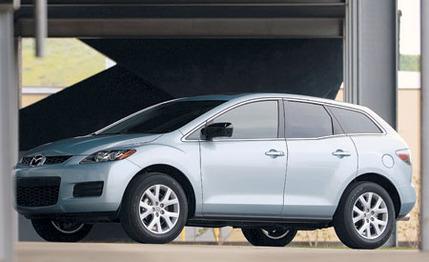 Road Test
Road Test
You don't have to be a radical environmentalist to question America's wholesale migration to SUVs. Many of us have wondered about the advisability of moving to heavy, less-nimble machines with greater appetites for fuel, even as we ponder the possibility that it may be the only way Americans - and particularly baby boomers - can get back into the two-ton behemoths they were sensitized to in their youth.
In any case, it's beginning to look as if the trend might reverse, with car-based crossovers evolving the species from big old trucks back into carlike wagons. Not completely, perhaps, but in growing numbers. Mazda says it has research to support that contention, particularly among married couples between the ages of 30 and 40 without children. Hence the appearance on these pages of the CX-7, a vehicle that makes considerable use of existing technology to provide the responses and agility Mazda was looking for in its crossover.
Chief among the packaging priorities was front-seat space, followed by luggage space, then rear-seat space. That's how it looks in the specs, and that's how it feels to tall drivers, too, who can find plenty of space and comfort in the front seats but not that much in the rear. That's entirely in keeping with CX-7 chief designer Iwao Koizumi's "advanced frontier" styling theme, which was intended to "combine dynamic movement, speedy shapes, and a bold presence."
In fact, Koizumi showed us slides of two design proposals: one the way it looks in these pictures and one with a thick, forward-leaning C-pillar. Either would work, we think, but only this one has the tricky kicked-up rear-greenhouse line. Under the swoopy skin are components sourced from other Mazda models. The turbocharged 2.3-liter engine is straight out of the Mazdaspeed 6 but for a revised turbocharger for improved low-rpm response, and it makes 244 horsepower, 30 fewer than in the sedan. The six-speed automatic is shared only with the V-6-powered Mazda 6.
As attentive readers may remember, this august publication went on record recently to say the Mazda CX-7 and forthcoming Ford Edge were essentially clones. Although the two are not clones, both are based on Mazda products. The Edge relies on Mazda 6 architecture, and the Mazda uses some Mazda 3 and Mazda 5 suspension layouts as well as the Mazdaspeed 6 engine, but much of it is unique.
The windshield, for example, has a 66-degree angle, making it the raciest glass in the segment. The steep rake required some relocation of the front-seat occupants relative to the engine compartment, but not enough to turn the Mazda into something like the late and unloved GM DustBuster minivans. It was enough to call for small quarter-vent panes, however, which work well to provide visual continuity with the outside world.
The outside world sees a distinctive exterior design, with a pronounced fender line that clearly evokes the company's RX-8 and to some extent even the separate pontoon-like fenders you see on ALMS race cars. At the front, yawning apertures gather in cooling air, and at the tail, careful window contouring and intricate taillights add interesting detail.
The interior is as deliberately detailed as the outside, with titanium-colored trim framing the instruments, center console, and armrests. Soft-feel moldings, carefully tuned knobs and dials, and contoured leather surfaces were selected to match the designer's vision of craftsmanship, and it's amazingly good for the price. Even the cloth seats have a fine-grained weave and look like good suit material.
Greeting the driver is a wheel we know from the Mazda 5 - a tidy three-spoke affair with the horn button where it used to be in a bygone era, smack in the middle. The airbag is a doughnut-shaped unit that fires from a housing encircling the horn button, and the overall effect is a wheel design that looks better than many recent airbag wheels.